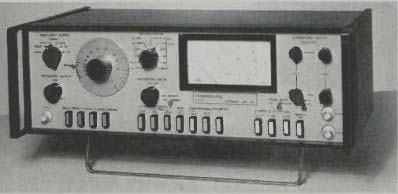
Elpa Marketing Industries, Inc.
Price: $1200.00
The Ferrograph RTS-1 is a compact and versatile instrument consisting of an audio oscillator, millivoltmeter, a wow and flutter meter, and a THD distortion bridge, all housed in one case measuring only 17 3/8 x by 10 by 5 5/8 in. and tipping the scale at 13 lbs. It is ideal for dealers or recording studios but it can also be recommended to the enthusiast who wants to check his own equipment. Although the RTS-1 is called "a tape recorder test set," it will obviously have many other applications. Reading from left to right, the controls are as follows: Range switch for OSCILLATOR OUTPUT (10 mV to 3 V) frequency dial and fine output control, MILLIVOLTMETER range switch, DISTORTION METER level control, and then the four BALANCE controls on the right. At the bottom are push-buttons for FREQUENCY RANGE, DISTORTION, CALIBRATION, LF CUT and WOW AND FLUTTER ranges. The ON-OFF Switch is on the right, and next to it are output sockets for a scope, etc. The meter it self has a 4 1/2-in. dial calibrated in rms, dB, and drift percent ages. Used as a millivoltmeter, the ranges are 1 mV FSD to 100 V in 11 switched positions, and the input impedance is 1 megohm on the lower 5 ranges increasing to 2 megohms from 300 mV up. The THD section is calibrated down to 0.1% FSD and the internal generator can supply a 1000 Hz test signal. The DIN standard is used for wow and flutter measurements and the input frequency is weighted with maximum response at 4.5 Hz and-3 dB points at 1.5 Hz and 15 Hz. There are two meter ranges--0 to 0.3% and 1% FSD. A zero-center scale also allows measurement of drift or speed changes. Here's how it works:
The internal 3.15 kHz test signal is recorded and then the tape is played back so the meter will now indicate on the "drift %" scale the percentage difference between the frequency of the reproduced signal and the 3.15 kHz test signal. Yet another facility provided by the RTS-1 is measurement of frequency response using the built-in generator which provides an accurate signal in the range of 15 Hz to 150 Hz.
Performance
The instrument has now been in use for some months and has certainly proved a lot easier to use than my standard assortment of test equipment with its bird's nest of interconnecting cables! All the specifications were met or exceeded and the built-in calibration facilities were positive and free from drift. Millivoltmeter frequency response checked out at ±0.3 dB from 10 Hz to 200 kHz with an accuracy well within the limits claimed for that range. The variable frequency internal generator was within 0.2 dB between 15 Hz and 150 Hz and the maximum output was just over 3 volts. Wow and flutter measurements were almost as accurate as those obtained with far more elaborate and complex equipment and in this respect, the RTS-1 will meet most requirements with ease. The same applies to some extent with distortion measurements and I found myself using the instrument for many quick checks. The filters only cover the range from 500 to 1500 Hz, which means that lab or design applications would be somewhat restricted--but for many other purposes this range would be perfectly adequate. A high-pass filter attenuating below about 400 Hz allows hum and low-frequency components to be assessed separately, if so desired. I found the four small balance controls quite tricky to use--especially when measuring distortion below 1%, and I thought it a pity some kind of slow-motion or vernier was not employed here. But all it takes is a little patience and unless the instrument is used almost continuously, it should cause no problems. Lowest repeatable THD measurement was about 0.08%. Inherent noise--partly due to oscillator leakage--made it difficult to get below that figure with any accuracy.
Incidentally, the instrument is fitted with folding metal legs which permit it to be raised at a convenient angle without propping it up with a meter or something. All-in-all, the Ferrograph RTS-1 is a most useful instrument which will find a place in many dealers' workshops, service centers, recording studios, and so on.
-T.A.
(Audio magazine, Jun. 1972)
Also see:
Ferrograph Series 7 Tape Deck (Jun. 1970)
Ferrograph Super Seven Model 7504-AHW 4-Track Tape Deck (Equip. Profile, Mar. 1975)
= = = =